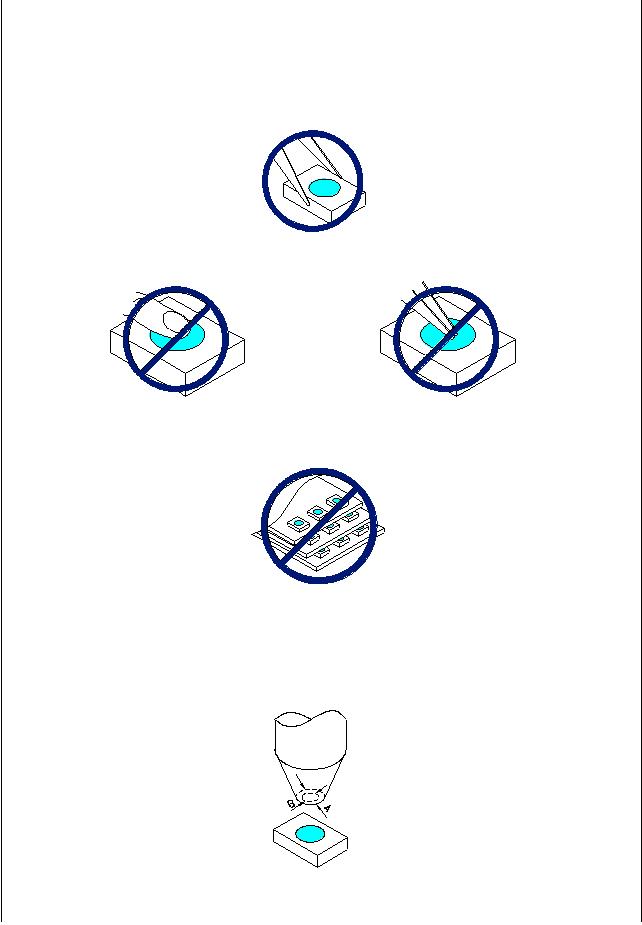SPEC NO: DSAK2496 REV NO: V.5 DATE: APR/12/2011
PAGE: 2 OF 9
APPROVED: WYNEC CHECKED: Allen Liu DRAWN: J.Yu
ERP: 1201005942
Handling Precautions
Compare to epoxy encapsulant that is hard and brittle, silicone is softer and flexible. Although its characteristic
significantly reduces thermal stress, it is more susceptible to damage by external mechanical force.
As a result, special handling precautions need to be observed during assembly using silicone encapsulated
LED products. Failure to comply might lead to damage and premature failure of the LED.
1. Handle the component along the side surfaces
by using forceps or appropriate tools.
2. Do not directly touch or handle the silicone lens
surface. It may damage the internal circuitry.
3. Do not stack together assembled PCBs containing exposed LEDs. Impact may scratch the silicone lens or
damage the internal circuitry.
4.1. The outer diameter of the SMD pickup nozzle should not exceed
the size of the LED to prevent air leaks. The inner diame-
ter of the nozzle should be as large as possible.
4.2. A pliable material is suggested for the nozzle tip to avoid scratching or damaging the LED surface during pickup.
4.3. The dimensions of the component must be accurately programmed in the pick-and-place machine to insure precise pickup
and avoid damage during production.
5. As silicone encapsulation is
permeable to gases, some corro
sive substances such as H2S might corrode silver plating of
leadframe. Special care should be taken if an LED with silicone encapsulation is to be used near such substances.



发布紧急采购,3分钟左右您将得到回复。
相关PDF资料
AAD1-9090BRGC-01/3
LED 9X9MM RGB CLR 3W XPOWER SMD
AAD1-9090QB10ZC
LED 1W HIGH POWER BLUE SMD
AAD1-9090QB11ZC/3
LED 3W HIGH POWER BLUE SMD
AAD1-9090SE28ZC
LED 1W HIGH POWER RED SMD
AAD1-9090SE9ZC/2
LED 9X9MM RED/OR 2W XPOWER SMD
AAD1-9090SY28ZC
LED 1W HIGH POWER YLW SMD
AAD1-9090SY9ZC/2
LED 9X9MM YELLOW 2W XPOWER SMD
AAD1-9090ZG10ZC
LED 9X9MM GRN CLR 1W XPOWER SMD
相关代理商/技术参数
AAAF5051-04
功能描述:大功率LED - 多色 RGB 635/515/452nm 2700/5000/1000 mcd
RoHS:否 制造商:Cree, Inc. 照明颜色:RGB, Cool White 波长/色温: 光强度: 系列: 封装:Reel
AAAF5060BESEEVGA
功能描述:标准LED-SMD CHAMELEON FULL COLOR RoHS:否 制造商:Vishay Semiconductors 封装 / 箱体:0402 LED 大小:1 mm x 0.5 mm x 0.35 mm 照明颜色:Red 波长/色温:631 nm 透镜颜色/类型:Water Clear 正向电流:30 mA 正向电压:2 V 光强度:54 mcd 显示角:130 deg 系列:VLMx1500 封装:Reel
AAAF5060BESUVGAC
制造商:KINGBRIGHT 制造商全称:Kingbright Corporation 功能描述:5.0mm x 6.0mm SURFACE MOUNT LED LAMP
AAAF5060BRGS-11
功能描述:标准LED-SMD RGB 621/525/470nm 300/650/180 mcd RoHS:否 制造商:Vishay Semiconductors 封装 / 箱体:0402 LED 大小:1 mm x 0.5 mm x 0.35 mm 照明颜色:Red 波长/色温:631 nm 透镜颜色/类型:Water Clear 正向电流:30 mA 正向电压:2 V 光强度:54 mcd 显示角:130 deg 系列:VLMx1500 封装:Reel
AAAF5060PBESEEVGEC
功能描述:标准LED-SMD RGB Full Color RoHS:否 制造商:Vishay Semiconductors 封装 / 箱体:0402 LED 大小:1 mm x 0.5 mm x 0.35 mm 照明颜色:Red 波长/色温:631 nm 透镜颜色/类型:Water Clear 正向电流:30 mA 正向电压:2 V 光强度:54 mcd 显示角:130 deg 系列:VLMx1500 封装:Reel
AAAF5060PBESURVGEC
功能描述:标准LED-SMD RGB Full Color RoHS:否 制造商:Vishay Semiconductors 封装 / 箱体:0402 LED 大小:1 mm x 0.5 mm x 0.35 mm 照明颜色:Red 波长/色温:631 nm 透镜颜色/类型:Water Clear 正向电流:30 mA 正向电压:2 V 光强度:54 mcd 显示角:130 deg 系列:VLMx1500 封装:Reel
AAAF5060QBDZGSEEC
功能描述:标准LED-SMD RGB Full Color RoHS:否 制造商:Vishay Semiconductors 封装 / 箱体:0402 LED 大小:1 mm x 0.5 mm x 0.35 mm 照明颜色:Red 波长/色温:631 nm 透镜颜色/类型:Water Clear 正向电流:30 mA 正向电压:2 V 光强度:54 mcd 显示角:130 deg 系列:VLMx1500 封装:Reel
AAAF5060QBDZGSEES
功能描述:标准LED-SMD RGB 621/525/470nm 1300/1000/250mcd RoHS:否 制造商:Vishay Semiconductors 封装 / 箱体:0402 LED 大小:1 mm x 0.5 mm x 0.35 mm 照明颜色:Red 波长/色温:631 nm 透镜颜色/类型:Water Clear 正向电流:30 mA 正向电压:2 V 光强度:54 mcd 显示角:130 deg 系列:VLMx1500 封装:Reel
